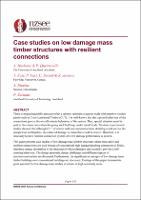Case studies on low damage mass timber structures with resilient connections

Download
Date
2021-04-14Authors
Hashemi, Ashkan
Fast, Tobias
Fast, Paul
Dickof, Carla
Jackson, Robert
Dunbar, Andrew
Zarnani, Pouyan
Quenneville, Pierre
Metadata
Show full item recordAbstract
There is increasing public pressure to have seismic-resistant structures made with massive wooden panels such as Cross Laminated Timber (CLT). It is well-known that the type and behaviour of the connections govern the overall seismic behaviour of the system. Thus, special attention must be paid to the connections when designing such buildings under lateral loads. Previous experimental studies showed that although CLT structures with conventional seismic detailing could survive the design level earthquakes, the extent of damage in connectors could be severe. Therefore, it is necessary to have resilient connection systems if a low damage performance is desired.
This paper presents case studies of low damage mass timber structures where innovative and resilient connections are used instead of conventional high damage/pinching connectors to firstly, introduce energy dissipation to the structures (without damage), and secondly, provide a self-centring behaviour. The design approach, design challenges and different aspects of erection/construction are discussed. Furthermore, the significant advantages of low damage mass timber buildings over conventional buildings are discussed. Findings of this paper demonstrate great potential for low damage mass timber structures in high seismicity areas.
